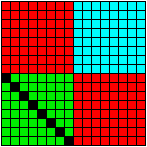
The Clifford Algebra Cl(8) has dimension 2^8 = 256.
Since 256 = 16 x 16 = 2^4 x 2^4, the full spinors of Cl(8) are 16-dimensional, and the half-spinors of Cl(8) are 8-dimensional.
Cl(8) has graded structure
1 8 28 56 70 56 28 8 1
The 28-dimensional grade-2 bivectors of Cl(8) form the Lie Algebra Spin(8).
The E8 Lie Algebra is the sum (on this page I am using the word "sum" very imprecisely) of
and
one 2^7 = 128-dimensional Cl(16) half-spinor space.
First, construct the 120-dimensional Spin(16) from Cl(8):
Since Cl(16) can be written as the tensor product Cl(16) = Cl(8) x Cl(8), the graded structure of Cl(16) can be written in terms of the graded structure of Cl(8) as follows:
1 8 28 56 70 56 28 8 1
8 64 224 448 560 448 224 64 8
28 224 784 1568 1960 1568 784 224 28
56 448 1568 3136 3920 3136 1568 448 56
70 560 1960 3920 4900 3920 1960 560 70
56 448 1568 3136 3920 3136 1568 448 56
28 224 784 1568 1960 1568 784 224 28
8 64 224 448 560 448 224 64 8
1 8 28 56 70 56 28 8 1
1 16 120 560 1820 4368 8008 11440 12870 11440 8008 4368 1820 560 120 16 1
Therefore:
Spin(16) = 120 = 28x1 + 8x8 + 1x28 = 28 + 64 + 28, and
plus the square of the 8-dimensional Cl(8) grade-1 vector space.
Second, construct the 128-dimensional half-spinors of Cl(16) from Cl(8):
The Cl(8) half-spinors are 8-dimensional, so that the Cl(8) full-spinor space is 8e + 8o = 16-dimensional, where 8e is one half-spinor 8-dimensional space and 8o is the other mirror image half-spinor 8-dimensional space.
ou can construct the spinor space of Cl(16) as the tensor product ( 8e + 8o ) x ( 8e + 8o ) as follows:
8ex8e + 8ex8o 8ox8e + 8ox8o
If ee and oo correspond to e, and if eo and oe correspond to o, we have:
64e + 128o + 64e
so that the Cl(16) spinors are (64 + 64)e + 128o = 256-dimensional, and
Therefore:

and
The second 28-dimensional Spin(8) corresponds to the Octonionic Spin(8) symmetries of each of the two half-spinor spaces and of the vector space. Note that the same Octonionic Spin(8) is used for each of the two half-spinor spaces and for the vector space, as is consistent with the fact (noted by Geoffrey Dixon in his book on Divison Algebras) that the left-adjoint and right-adjoint actions of the Octonions are both isomorphic to each other, and are also isomorphic to the 8x8 matrix algebra over a real 8-dim vector space.
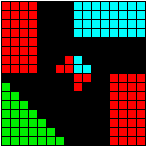
E7 is the sum of 28-dim Spin(8) plus Quaternionic versions of the two 8-dim half-spinor spaces of Cl(8) and the 8-dim vector space of Cl(8), each of which is 4x8 = 32-dimensional.
The central 9 elements correspond to the Quaternionic SU(2) symmetries of each of the two half-spinor spaces and of the vector space. Note that distinct Quaternionic SU(2)s are used for each of the half-spinor spaces, as is consistent with the fact (noted by Geoffrey Dixon in his book on Divison Algebras) that the left-adjoint and right-adjoint actions of the Quaternions are not isomorphic to each other, nor are they 4x4 matrix algebras over a real 4-dim vector space.
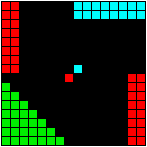
E6 is the sum of 28-dim Spin(8) plus Complex versions of the two 8-dim half-spinor spaces of Cl(8) and the 8-dim vector space of Cl(8), each of which is 2x8 = 16-dimensional.
The central 2 elements correspond to the Complex U(1) symmetries of the spinor spaces and of the vector space. Note that the same Complex U(1) is used for both of the half-spinor spaces, as is consistent with the fact (noted by Geoffrey Dixon in his book on Divison Algebras) that the left-adjoint and right-adjoint actions of the Complex numbers are both isomorphic to each other, but are not 2x2 matrix algebras over a real 2-dim vector space.
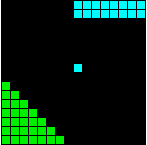
D5 is the sum of 28-dim Spin(8) plus a Complex versions of the 8-dim vector space of Cl(8), which is 2x8 = 16-dimensional. D5 is the Spin(10) Lie algebra of the Clifford Algebra Cl(10), which factors by tensor product into Cl(10) = Cl(2) x Cl(8). Since the graded structure of Cl(2) is 1 + 2 + 1, the graded structure of Cl(10) is
1 8 28 56 70 56 28 8 1
2 16 56 112 140 112 56 16 2
1 8 28 56 70 56 28 8 1
1 10 45 120 210 252 210 120 45 10 1
The 1 of the 45 corresponds to the grade-2 bivector of Cl(2), acting as U(1) on the 2-dim vector space of Cl(2). It is represented on the pattern by the central element corresponding to the Complex U(1) symmetry of the Complex version of the Cl(8) vector space.
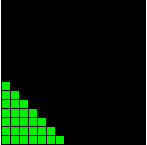
D4 is the 28-dim Spin(8) of the Cl(8) Clifford Algebra with graded structure
1 8 28 56 70 56 28 8 1
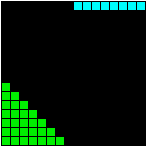
B4 is the sum of 28-dim Spin(8) plus the 8-dim vector space of Cl(8). B4 is the Spin(9) Lie algebra of the Clifford Algebra Cl(9), which factors by tensor product into Cl(9) = Cl(1) x Cl(8). Since the graded structure of Cl(1) is 1 + 1, the graded structure of Cl(9) is
1 8 28 56 70 56 28 8 1
1 8 28 56 70 56 28 8 1
1 9 36 84 126 126 84 36 9 1
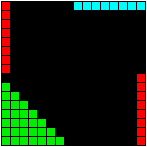
F4 is the sum of 28-dim Spin(8) plus the two 8-dim half-spinor spaces of Cl(8) and the 8-dim vector space of Cl(8).
Note that the 16-dimensional symmetric space F4 / Spin(9) is the Octonion Projective Plane, which is represented on the pattern by the two 8-dim half-spinor spaces of Cl(8).
......